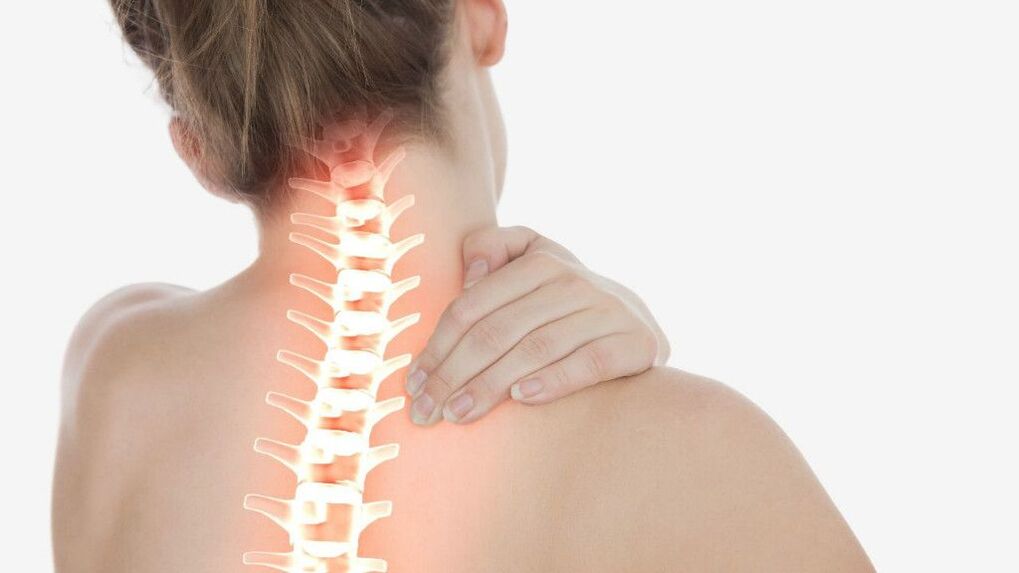Cervical spinal osteochondrosis is a degenerative and dystrophic disease that affects the neck intervertebral disc.This pathology is the most common pathology of the spine.

Symptoms of disease
When the disease progresses, characteristic symptoms appear.They include the following manifestations:
- Weakness
- Dizzy
- Headache
- Noise in the ear
- Changing the function of the vision organs (decreasing its severity, flashing flies in front of the eyes)
- An increase in sensitivity in hand
- Numbness
- Then one can generally stop moving his hand
- A feeling of stiffness in the upper limb joint
- Crunch on the neck
- Feelings of stiffness and pressure in the chest.
Cause
The main causal factor of cervical spinal osteochondrosis is as follows:
- Small mobility of the neck, leading to the fact that the intervertebral disc loses the fluid, it also leads to loss of cartilage elasticity
- The descendants of the burden, which determines the reserve of the strength of the intervertebral disc
- Microtraumatization of cervical spine with a sharp turn, tilted head, etc.
- Metabolic disorders that negatively affect the cartilage in the intervertebral disc.
Diagnostics
Diagnostic searches for cervical spinal osteochondrosis include the following studies:
- X -ray
- Computed tomography
- Nuclear-magnetic resonance
- Electromyography.
Each of the above studies brings certain diagnostic information.The first three allows you to identify direct changes in the spine, characteristic osteochondrosis.Recent studies allow you to diagnose complications of osteochondrosis, consisting of damage to the nerve stem.
The X -Ray examination is conducted on various aircraft, and the scenery is also performed for more accurate details of change.This study reveals calcinates in spinal ligaments, changes in the height of the intervertebral disc, the deformation of the cervical area, etc.
Calculated tomography and nuclear magnetic resonance allow you to get the most reliable information, so it is recommended to use it in a complex diagnostic case.
The research of electromyographic conductivity in nerve fiber, which is very frequent with cervical spinal osteochondrosis is reduced.This is due to the fact that with the decrease in the height of the intervertebral disc, the condition is created for the compression of the nerve root.Therefore, clinical symptoms such as increased sensitivity, paresis and paralysis appear.
Complication
The absence of timely treatment of osteochondrosis of the cervical spine can lead to the development of the following complications:
- Paralysis and paresis of upper limbs on one or two
- Brain ischemic stroke.
Disease
The goal that the treatment of osteochondrosis is chasing is as follows:
- Reduce the severity of the pain syndrome
- Prevention of development of pathological changes.
The following methods are used to implement this goal:
- Manual therapy is carried out
- Acupuncture
- Physical Education Medicine
- Gymnastics
- Swim.
The purpose is shown in parallel:
- Chondroproprotectors, which increases cartilage resistance and allow it to recover
- Nonsteroidal anti -inflammation that reduces the severity of pain.
A unique method of treatment
- Applied Kinesiology
This is a method of diagnosing and treating spinal diseases, joints and nervous systems based on muscle testing.Doctors with the help of hand studying the condition of the tissues and organs.
- Treatment with leeches
Together with leech bites, about 100 active components of biologically arriving in human blood.This helps to cleanse the blood vessels, eliminate blood clots and interfere with its formation.
- Reflexology
Acupuncture helps cure osteochondrosis, radiculitis and other spinal and joint diseases.Procedures relieve pain, heal the body and strengthen immunity.
A group of risks
In the risk group, the following people categories must include:
- With the descendants of the burden
- Motive
- Has a background pathology process.
Prevention
Steps -Preventive steps to prevent spinal osteochondrosis, are as follows:
- The right posture while sitting
- The replacement of the load and rest
- Heavy exceptions (in this case, better give priority to a backpack)
- Underlying medical examinations for neurologists and orthopedic for early detection of cervical spinal osteochondrosis.
Diet and lifestyle
In the event of osteochondrosis, it is necessary to make specific adjustments to the lifestyle.They are as follows:
- Treatment of background pathological processes, leading to osteochondrosis if detected
- Heavy exemption
- Nutrition normalization - fat rejection, fried, acute, salty, increasing plant fiber content and products with chondroitin (jelly, jelly) in the diet
- Adequate physical activity rate.



















